Last updated: May 21, 2021
The November 8, 2019 Google update may have been a link related update
Google has been much better lately at informing the SEO community about large algorithm updates. On November 8, 2019, however, Google appears to have pushed out a significant update. They have said nothing about this update other than these tweets:
What can we learn from these tweets? Here is our interpretation:
- Google ran several updates last week. But then, they are always running updates. Some are more impactful than others.
- The fact that Google didn’t share about this update means it may be possible that there is no means of recovery if you were hit. (We’ll discuss this more later in this article.)
- Google ended these tweets by referring to their blog post on core updates. This blog post discusses Google’s guidelines and has a heavy focus on E-A-T. The question though, is whether this current update was a core update or not.
Update (added May 21, 2021)
It turns out that November 8, 2019 was quite a significant update for many sites. Over the last two years, we have received many requests for help for sites that started to see traffic declines on this day. We do think that this update changed how Google values links. As described throughout this article, most of the sites affected had used link building tactics that many SEOs consider "white hat" including getting links from guest posting, roundup posts, top 10 lists, etc.
We have not had significant success in reversing these traffic losses by disavowing. We have seen improvements in sites that follow our general recommendations for improving overall site quality which are described at the end of this article
We do not believe that Google penalized sites that used these types of link building tactics. Rather, we believe that Google got better at determining that this type of link is not one they want to count as a recommendation that should pass PageRank.
Our new recommendations for what you should do if affected by the November 8, 2019 update are laid out at the end of this article.
Early thoughts on what happened November 8
We often joke that Google tends to run major updates when I, Marie am traveling. I’m sure that this is not the case...it’s probably just coincidental as I travel a lot! While I was not away this weekend, I did actually take the weekend completely off, without even checking in on Twitter. On Monday morning, I saw many tweets and mentions from people who had suffered massive drops in Google organic traffic over the weekend. We also had a large influx of requests come through our contact form from businesses who had very large traffic drops and were looking for help.
In this article, I will share with you our early thoughts on what is going on with this update. Most of our client base saw very little change in rankings and traffic beyond what is expected for the season. However, for those who did see changes in traffic, we found some very interesting correlations.
Please know that this article contains a lot of theory. We do feel strongly that this update is closely tied to link quality, but we do not know this for sure. There is also a possibility that thin content could play a role. We will update this article as more information becomes available.
As with any significant update, my team and I have gathered information from many sources to find examples of sites that were affected either positively or negatively at this time. We look at our own client base of hundreds of sites, our intake emails, Twitter, several help forums, Search Engine Roundtable and other sources. Something that we noticed is that of the sites that saw declines this weekend, there were quite a few sites from the following industries or categories:
- recipe bloggers
- affiliate sites
- travel sites
- aggregator / directory sites
Link issues
Almost every site that we looked at that saw drops had issues with unnatural links pointing to their site. At first we wondered if the data was skewed, as we do have a lot of clients that originally came to us because they potentially needed disavow work. But, we do not think this is the case.
Here is one site that we filed a thorough disavow for just over a year ago. We did no other work for this site other than a link by link audit. We filed a disavow with hundreds of domains in it, many of which contained links in articles that were very clearly made for SEO purposes alone. They have been seeing incredible improvements since then and then dropped significantly on November 8:
 We took another look at this site’s link profile on Ahrefs and noticed there had been an influx of links recently.
We took another look at this site’s link profile on Ahrefs and noticed there had been an influx of links recently.
In looking at these links, many were the same type we previously had disavowed. It looks like this site may be experimenting with purchasing Private Blog Network links. If so, it’s not working well for them!
Another site that we recently reviewed is seeing a 35% drop in Google organic traffic. In the links section of their site quality review, we wrote that we had “serious concerns with the quality of [their] link profile”. They had loads of in-article links that were definitely there just for SEO reasons.
There were several other sites with a similar pattern as well.
We then looked at our clients who had seen improvements over the weekend. We had several sites seeing increases on November 8, 2019. Here are a couple for which we have permission to share:
Please know, however, that it is really early to say whether these increases were solely due to an algorithm update. We’ll need more time to say that for certain.
None of our clients who saw nice improvements were ones for whom we had recommended a thorough link by link audit. It is interesting to note that some were sites for which we had recommended trimming out a large amount of thin content. We’ll note this but given that some of the sites that saw improvements have not yet cleared out thin content, we feel that this is likely coincidental rather than a cause for their gains.
We feel very strongly that this is a link related update. It could have other components, but links are likely very important!
Our current theories on what Google changed on November 8, 2019
Keep in mind that at the time of writing this, less than a week has passed since this update happened. We will hopefully have more data soon and will update this post if our theories change.
It is possible that Google has gotten better at figuring out which types of links to count as mentions.
Most of the sites that saw drops in traffic had links that most of us would likely call, “grey hat” and some of the SEO community (although not us), could even consider “white hat”. These are links that for the most part aren’t illegal or even unethical, but really don’t truly represent natural mentions. Here are some examples of the types of links that we feel used to work to help sites, but may no longer do so as of November 8, 2019.
Footer Links
Many of the sites that saw drops were web design sites or other similar sites that have links from their clients’ footers. An example would be a site that makes websites and includes a footer link on each of their clients’ sites saying, “Web Design by ABC Websites”.
It is interesting to note that Google made changes to their guide on link schemes to add the following (the bolded part is new):
“Requiring a link as part of a Terms of Service, contract, or similar arrangement without allowing a third-party content owner the choice of qualifying the outbound link, should they wish.”
This used to say, “Requiring a link as part of a Terms of Service, contract, or similar arrangement without allowing a third-party content owner the choice of using nofollow or other methods of blocking PageRank, should they wish.”
“Qualifying the outbound link” links to Google’s page describing rel=nofollowed, rel=sponsored and rel=ugc. We believe that the point they are saying here is that if you are getting links because it’s a requirement of using your product, then those truly are not natural mentions or recommendations of your website. If you provide customers with a web template and a requirement for them to use it is to include a footer link back to you, this goes against Google’s guidelines. Links like this should be either nofollowed or should use rel=sponsored. Either is fine to use.
Examples of this could include a web design company that includes a link in each of their designs that points back to their site, or perhaps a directory that will give you a higher placement on their website if you link back to them.
Although this is a few years old, we have good information here on footer links and SEO.
Reciprocal blogger links
We feel that one of the reasons why many recipe sites saw a decline in traffic could be that they were previously benefitting from link schemes. We saw that many of the recipe sites who saw drops, had a lot of links that look like this:
We’re not saying that these are necessarily unnatural! If you have a recipe blog and other recipe bloggers truly want to recommend your website, this is great. However, for some of the recipe sites that saw drops, we saw enough of this type of link that we feel there was potentially a pattern of manipulation. Even if these links are not all reciprocal links, we feel that these links could be the type of link Google talks about in their link quality guide, where they mention, “Excessive link exchanges ("Link to me and I'll link to you") or partner pages exclusively for the sake of cross-linking.”
If you are a blogger who is involved in a program whereby you regularly link out to other bloggers and in turn, they include links to you, then these links may have helped in the past. The question now is whether these links are actually hurting sites or whether Google is simply recognizing them as manufactured votes for your site and just discounting them.
Please know that it is perfectly acceptable in Google’s eyes to ask other people for a link. It’s the scale and also the intent to manipulate rankings that is the main concern.
Top x lists
Several of the sites that we reviewed that saw drops seemed to have a disproportionate number of links from top 10 lists. We see this a lot in link audits and often struggle when we are determining whether these are actually natural links.
Take for example, an article on an authoritative site that is called, “The Top 10 Salon Software Products”, or “Here are 8 amazing pumpkin pie recipes”, or “Traveling to India? Here are the best travel blogs”.
When we see a site that has a large number of links in lists like this we start to wonder how those links were obtained. On one hand, your site may truly be one of the best of its kind and it may get mentioned a lot. We’ve been mentioned in several posts that talk about the best SEO blogs. (Thank you!) And we certainly did not pay for any of those.
But, in some cases, the way you get on these “top x” lists is to pay for inclusion. We think it is possible that Google recognized that many of these links are not truly votes for your site. We’re not as confident on this point just yet though, as we are with the above theories.
In-article links and PBNs and possibly some guest posting
Google’s link scheme guide has always recommended against, “exchanging money for links, or posts that contain links”. Links from Private Blog Networks (i.e. a network of websites that are only set up to be able to link out via articles) and articles that were written solely for SEO have been considered unnatural by Google for years now.
We do think it is possible that Google has now gotten better at determining which links from articles are truly mentions of your site and which are there simply for the PageRank.
We have seen several reports of Blackhats complaining that their PBNs stopped working for them with this update.
Is the November 2019 Google update connected to BERT?
Given that Google recently announced they are now using BERT to better understand queries, we did spend some time theorizing that perhaps this update could be connected to BERT. At this point, this theory is a little weak. The idea is that it is possible that BERT allows Google to do a much better job at understanding the content on a page. Let’s say that these are two competing pages:
1) A recipe page that is relatively good and is linked to from many recipe bloggers.
2) A recipe page that is REALLY good but does not have a lot of links.
In the past, the first page would be much more likely to rank as it has links from many bloggers. But, what if Google’s newfound ability to better understand language allows them to determine that the content on page 2 truly is better? This could mean that it starts to outrank page 1 even without links.
Or, in other words, page 1 may have previously ranked well on the power of links, but now that Google can better assess page quality, those links to page 1 are no longer as important in Google’s ranking decisions.
We’ll keep this theory in mind going forward, but at this point we really do think that this update was mostly about Google’s ability to detect which links are true mentions for your site.
Should you disavow if you were affected by this update?
This section has been updated in May of 2021 to reflect our recommendations after analyzing many sites affected by this update.
If you have been building links with any of the link building tactics mentioned above, it does not appear that doing a link audit and filing a disavow will mitigate these losses. The only sites that we feel we have been able to help with a disavow recently are those who had previously done a massive degree of manipulative link building. We've described this more in our recommendations for disavowing in 2021.
If your traffic started to decline on November 8, 2019, this likely means that you lost some PageRank from links that Google used to count as recommendations. To recover lost rankings for these pages, we recommend the following:
- Ensure there are no technical issues impeding Google's ability to crawl the page and see the content.
- Critically look at this page in the eyes of the questions Google says to ask yourself in their article on what website owners should know about core updates.
- Do all you can to demonstrate E-A-T on your site and off as well as described in our article on E-A-T and SEO.
- Look at pages that are now outranking yours and ask yourself why users may find these more valuable. As Google's language understanding capabilities improve, we believe they will get better at recognizing which pages do the best job of helping a searcher find what it is they set out to research in the first place.
If you need help improving the quality of your website, here is more information on our site quality reviews.


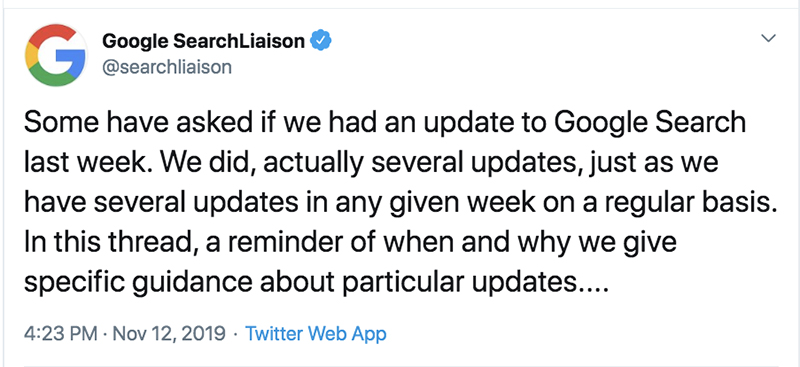
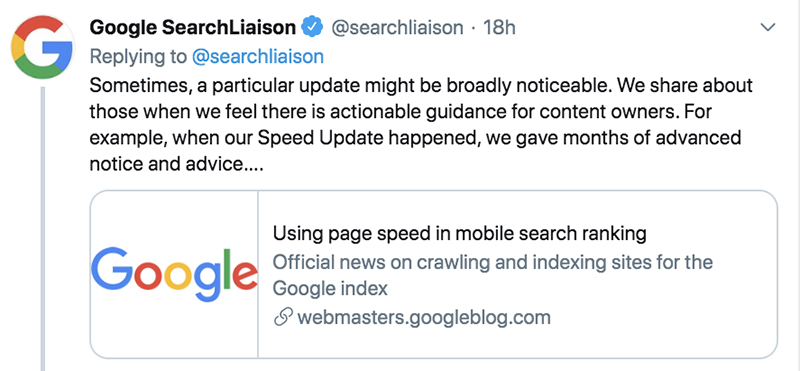
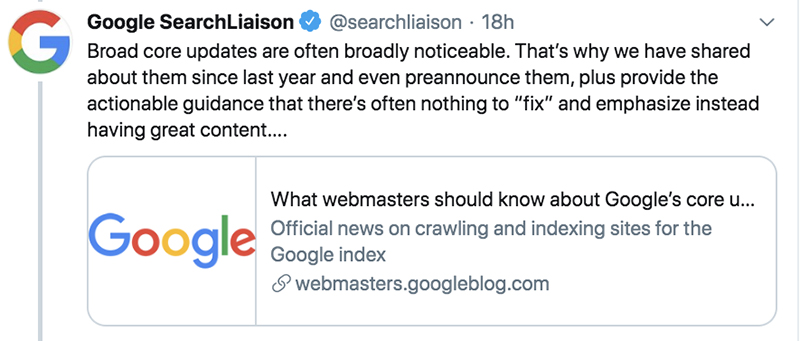
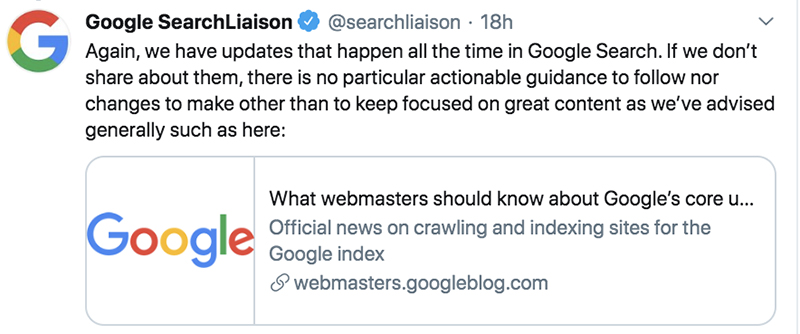
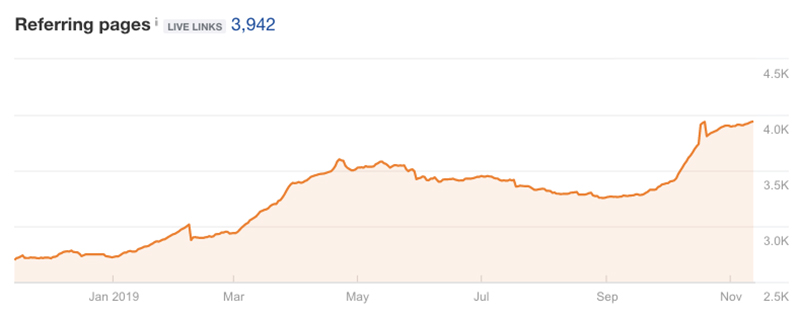



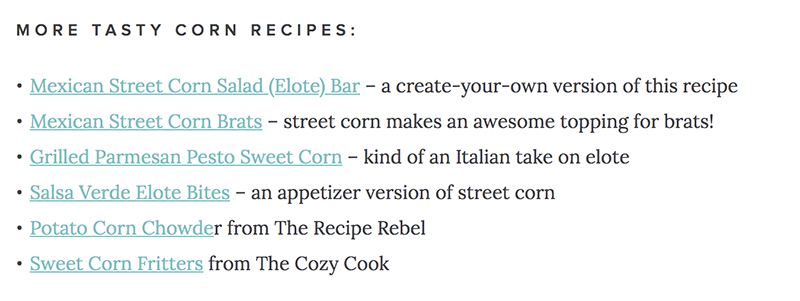

Comments
Well Marie, it really look like a link related update. I dont know exactly how to behave because in my case i habe never done any kind of link building campaign, neither paid for links and absolutely nothing purposely of that kind, BUT these last months i saw a lot of very strange links pointing to my website, very spammy, lots of hotlinks, and things that i absolutely did not have any responsibility, so i decided to not do nothing because i thought that Google will be intelligent enough to know that those links were not created by the webmaster… but.. surprise!! I was hitted hard on November 8 🙁
What’s the deal then? Even if we don’t take part on manipulative link creation, we are on risk of being hitted?
Why a website receive lots of unsolicited spammy links?
Are negative SEO attack a real thing? I believed not, but now i don’t know what to think..
I suppose now i have to do a deep link revision and disavow.. and in the future check my backlink profile EVEN if i have not done any kind of backlink creation campaign..
this is starting to get complicated and shady 🙁
It’s hard to say without looking at your link profile, but these spam links are likely not to blame for your drop. I really feel that Google can ignore spammy negative SEO attacks.
Hi Marie,
So I’m wondering, if that’s the case, then why would Google even introduce the “Disavow” feature in the first place?
And if it can indeed ignore such links, wouldn’t disavowing be a huge waste of time and money (for those who pay to have it done)?
Thank you in advance, Marie.
Penguin is really good at ignoring spammy links in my opinion. However, the types of links that we feel we are seeing benefit from disavowing these days are ones where there is a clear pattern of manipulation happening. I don’t think it’s as granular as Google’s algorithms saying, “Ah, this one link is unnatural, so we’ll ignore it.” Rather, if they are seeing a pattern of potential unnatural linking, they may choose to put less trust in ALL of your site’s links. This is where disavowing the links that were made by you (or an SEO company acting on your behalf) to increase rankings can often help.
Love the article Marie, but I’m one of those who never, ever exchanged links. I focus on long articles, personal experiences and long tail keywords. Of course I have been guestposting for other bloggers, could that be an issue too? Other than that I have no idea what I’ve done wrong. My blog has good scores at speed tests and this year I have been working extra hard to publish quality articles, as often as possible. It’s quite depressing to think it was all for nothing…
When you say you are guest posting for other bloggers, do you mean you are getting published on their sites and then getting a link back to yours? If so, there’s a good possibility Google is able to discount those links now as they really aren’t recommendations for your website.
“John Mueller has mentioned that if a site has enough unnatural links, it can indeed hurt them”
Acknowledging bad links is something that Google should NEVER have done. They should simply disregard them. Any sort of negative follow on effect from unnatural or “bad” links means that negative SEO is a real thing, which is f*cking stupid. All this does is lead to webmasters running around spending their time a) worrying about bad links and b) disavowing links all over the place – not to mention clogging up forums and FB groups asking “do these links look spammy??”.
The whole “bad links” thing is ridiculous.
In 2016, Penguin 4.0 did a great job in accomplishing this. Google became really good at just ignoring spammy links. The problem though is that Penguin is not perfect in every case.
Let’s say a site has a mixture of really good links and also has been using widespread article marketing for link building (which is against Google’s guide on link schemes). I do not believe that Google looks at each link and says, “Ah, this one is paid, but this one is a valid mention.” Rather, they’re looking for patterns. So, for the site that has in-article links and most of those feel unnatural to Google, what should they do?
What we believe is happening is that the algorithm is saying, “OK, something doesn’t seem right here. There are enough links pointing to this site that we feel were made just to increase PageRank. So, we’re going to put less trust in all of their links overall.”
One of my websites has 100% natural links and has been hit… its recovering now though.
Hi Marie,
My digital agency website had a major drop in keyword ranking in late October right after I set live and indexed a new website that had 1300 pages. It turns out my backlinks skyrocketed and I think Google penalized me for that. Based on your article I’ve now put nofollow on about 12 websites I’ve created. Putting a link in the footer isn’t something I always do. I’m hoping I have a bounce back from this however the penalty started around October 20th for me which preceeds the Google update you are mentioning here. Curious if they did a rollout for certain websites before the major update on November 8th? I’ll be watching my rankings closely now that I’ve updated the links to nofollow 🙂 Thank you Marie!
Thank you for the Google Update post.
Hi, Marie!
I hope, it will be interesting for You. Old and trustworthy Russian dentist site (24stoma.ru) day by day loose organic traffic. After the last update, they lost 27,3 % Google organic traffic.
Any idea how to fix it?
I think this is the best analysis of what happened with 7-8 November Google Update.
Do you think is better disavow links or , if they can be edited , just to add rel nofollow or rel sponsored ?
Sorry for my bad english.
This is still up in the air!
If Google is truly devaluing the types of links that come from link exchange and other methods mentioned in this post, then it can be hard to decide whether to disavow or not. On one hand, if I’m wrong you could be doing more harm than good. It could also be a waste of time if you are asking Google to ignore links that they are already ignoring. But, for sites that have a large number of links like this, it is possible that those links are suppressing the site’s rankings overall. In those cases, disavowing (or having the linking sites add rel=nofollow or sponsored where possible) could help. It’s a tough call.
My websites have been greatly affected by this update. I realize that the links are not beneficial and the content of spam has a big impact. Besides that, Google is promoting website speed and mobile experience for this update.
I can tell every time Google has a major update because my traffic drops dramatically. After this last one I’m only getting about 25% of the traffic I got just over a year ago.
Like the another commenter here, my blog is based on my personal experiences. I have never guest written or used articles written by other people. Occasionally I link to outside articles that provide more information on the subject.
The only other links I use are Amazon affiliate links and there are not very many of those.
I have no idea what to do. This is so unfair.
Hey Marie – excellent article full of great advice.
One piece of advice I can give to anyone who got hit in this update is to let the dust settle. Wait a few months to look at the trend. Google does lots of testing all the time.
Keep creating top content, engage with your audience and success will follow.
If your site experienced an increase in traffic recently – this update could be just a correction. Possibly Google reversed some of the changes it did a few months ago – it is all part of their ongoing and LONG term testing.
My impression is that in the past 2-3 years updates can create huge spikes (up or down) so take it into consideration.
Keep up the good work Marie
Same happened with my site (non english) – 40% drop, bought only two backlinks.
Hey Marie – I would be interested to get your educated opinion about an article published in the The Wall Street Journal last week:
The Wall Street Journal claims that Google has been blacklisting sites
The WSJ claims that Google made algorithmic changes in favor big businesses over smaller ones
They claim the blacklist policy instructs engineers, known as ‘maintainers’, to focus on sites that actively aim to mislead
This does give a very plausible explanation to what we see in terms of the “Medic update”. I felt for a very long time that the results are manually curated to prefer a very small number of large US websites. This also explains why it’s impossible to recover from the medic update despite making extensive changes.
What is your opinion about this?
Hi James,
I covered my thoughts on the WSJ in the paid version of our newsletter:
https://courses.mariehaynes.com/search-news-you-can-use/episode-109-light-version/
And also in my podcast episode November 20:
https://courses.mariehaynes.com/search-news-you-can-use-podcast/
The journalist who interviewed me for that piece was incredibly fixed on trying to prove that Google was manually inserting big brands into the tops of the SERPS, but in the examples she gave me there were other more plausible reasons. I don’t think the WSJ article revealed anything, personally.
I’ve also noticed it. I got over 30% drop, but the much bigger sites are doing quite well, or even grew from the update.
This article was very useful to me Marie. Thank you so much for taking the time to write it. Implementing a few things based on your ideas, will try to let you know if they work out!
Hi Marie! We have built our business model by linking to other ethical and vegan businesses via links in many ‘listicles’. For example, every monday, we link to around 30 sites in articles like 30 Vegan Burgers for Your Barbie or 15 of the Best Vegan Flats for Fall. We make money via affiliate links, but do not do link building schemes. Could publishing these types of articles be hurting us?
What I’d be more concerned about is whether those sites you list in your listicles are also linking back to you. If you legitimately want to recommend some great sites to your readers on a regular basis, that’s great. But if a site starts doing that so that they can also get links back, and if it happens on a large enough scale, this could be an issue.
If your traffic dropped on November 8, I’d perhaps take a look at whether you could be seen as taking part in a link scheme. But otherwise, you’re probably ok.
I see a decline by 2 of my clients. But only in google analytics, not in google search console.
Even the numbers in google search console shown in google analytics are stable. But Google Analytics is down by 30+ %.
– Is anyone else experiencing this huge difference between google search console and google analytics?
In google analytics views and users are down, sessions per user and session time is up. Both my clients show the same ups an downs.
It’s possible that this is a bug. Barry Schwartz reported on some Google Analytics issues happening recently, here:
https://www.seroundtable.com/google-analytics-reporting-bugs-28692.html
Hi Marie,
I lost a whopping 50% of my Google organic traffic on, or around November 8. As a result, my business has been hit hard. Ranking for business generating terms fell by around 5 places, although I still have page one listings for some keywords. Business leads are down sharply.
I have just completed a link audit using a link dump from Google Search Console. This audit found there are in-content links from many different industry-related articles that people have written, which point to different in-depth free resource pages on my site. These quality free resources offer training and HR advice on a number of important topics. I have had no involvement in writing any of these linking articles, hence none of these backlinks has been added by me, nor have they been bought, nor are they guest-posts. As a result, there is a good mix of anchor text used, including many links which use just the landing page URL. Although some links use the page title, which is optimised.
In addition to the natural in-content article links described above, there are quite a few links from plagiarists, who have stolen content from my site and reproduced it on their domain for their own financial gain. A lot of the content they have taken contained optimised internal links. Worryingly, these links become optimised external links when my content is cut and pasted onto their site. There are some plagiarist pages which are stuffed full of these optimised links pointing back to my content. I have tried to get this plagiarised content removed, threatening DMCA action, but to no avail. I now plan on disavowing the plagiarists’ domains.
As well as this, there are the usual junk directory links pointing to my site. I am assessing the quality of these directories and will probably disavow some or all of them.
It is concerning that my site got absolutely slammed on November 8, yet I haven’t done any link building, link exchanges or guest posting. The concerning thing is Google might think I have, given my link profile has a lot of article based in-bound links. It’s now super-hard to know how far to go with the disavow file. I have no way of telling whether this update just removed the positive effect these links were having, or whether I have actually been penalized. I do however get sick of being unfairly targeted by Google’s updates.
Hi Steve. It’s hard to say much without knowing your site. In general though, if you did not make those links, they are probably not causing problems. While we do think that the majority of the sites that saw drops November 8 had link issues, there certainly could be other things going on as well.
Interesting about footer links. I will be updating some websites. Great site keep up the good work. I love reading about SEO and digital marketing.
Hi Marie,
Since this Google update looks to be connected with links and their quality, I would like to ask you about a link issue and hear your opinion.
This is about some “strange” backlinks that when you open then, they are domains parked on GoDaddy. There are just a few topics on this issue, but there is no in depth explanation or solution.
So what do you think? Have you ever seen/analyze those links? Do we need to disavow?
Thank you
ST
Google has told us that the only links that pass signals in their algorithms are ones that come from indexed pages. If you had links on domains that now are parked domains, this really shouldn’t hurt you.
But, if you have LOTS of these…like hundreds, that could be a sign of an attempt at some type of sneaky negative SEO tactic. While it’s unlikely for the tactic to work, it is not a bad idea to look deeply for signs of the website being hacked or other types of negative SEO attempts.
Thank you for your reply.
Yes the links are hundreds and not only on homepage, but all around the landing pages.
Links are shown on Google Search Console, so is that means they are indexed?
I have also found a few more that they look like backlinks from images and here’s the bad news… When I open url, just before loading is completed they redirect on casino, bet and this kind of pages.
So I guess it’s time to disavow.
Thank you
ST
Hi,
Our website was hit by this update really badly. We had done NO link building since the site started, focusing mostly on providing good content. However, since August 2019 onwards, we started getting a lot of one-way links from random non-relevant blog posts and auto-generated image websites. We didn’t disavow any of these links, considering the mixed feedback of this tool. After November 8 hit, we decided to disavow a lot of them (over 2000) but rankings are still not improving. In fact, more keywords continue to fall.
Not sure how to tackle this update.
Taking a very quick look, this site may be challenging to recover. First off, I greatly respect anyone who can write in multiple languages. However, the posts read like English is not your first language. In our experience, Google will want to see this fixed in order to rank the site again.
Next, I don’t really see a focus for this site. The posts I saw contained general info on so many subjects. It has articles on apps, law firms, and digital marketing and each of those I opened seemed to contain general information that didn’t really add much beyond what Google already has indexed.
I’d strongly encourage you to read the questions that Google says to ask in this blog post of theirs (under “focus on content”): https://webmasters.googleblog.com/2019/08/core-updates.html
Hi Marie,
Do you think it would be feasible to work on increasing E-A-T content on a small affiliate site and see decent improvements?
I have some spammy web 2.0s in my profile but I would rather build better links with content then try to disavow and get Google’s anti spam team on my site.
Thanks for any feedback.
Best,
Chris
This is a question that is really hard to answer without knowing more specifics. With that said, if most of your rankings are propped up by web 2.0 links, this would concern me! I’ve heard other people say they don’t want to disavow because they’re afraid that it will attract attention and they could get a manual action. John Mueller has refuted this saying that this is simply not true. If you have unnatural links, I would highly recommend disavowing them.
This may help:
https://www.mariehaynes.com/does-disavowing-links-work-2019/
In regards to “increasing E-A-T content”, that’s something that would take me a couple of hours to answer fully. Having better E-A-T is important if you want to rank for YMYL queries. There are many components to it though including being known as an authority in your space, having good reputation, etc. But in general, if you have content that is expert written and quoted by other experts in your space, this should be your goal.
Hi Marie,
Thanks for your great content. Now, 3 month after November 8th update do you still think it related to links?
Do you think a footer link from a .gov site is also dangerous?
My site ( 30% drop ) has a few footer links as mentioned.
Please let me know your thoughts.
Thank you 🙂